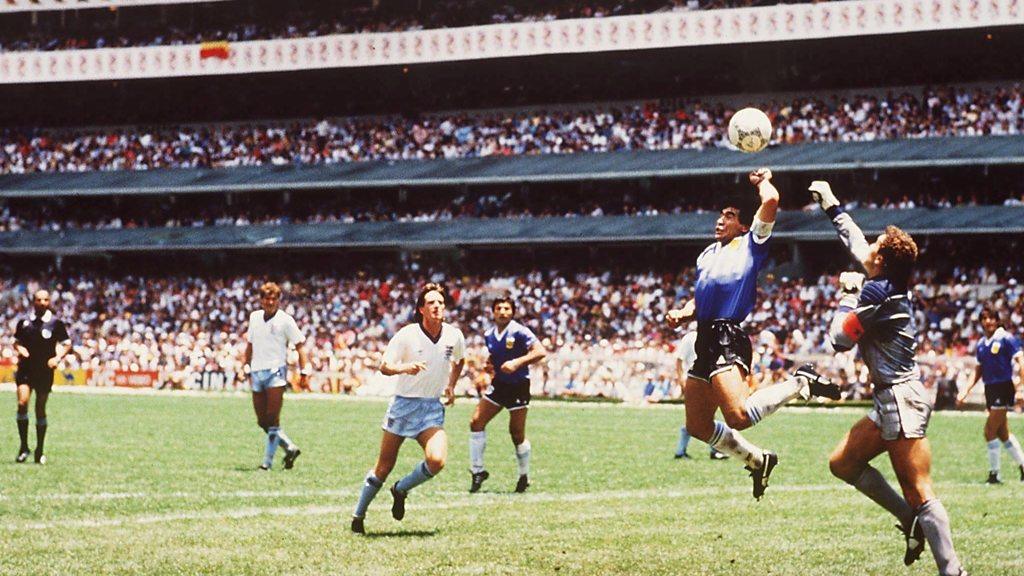VAR: Willian 'dive', Iheanacho goal - how does the system work?
- Published
- comments
The video assistant referee (VAR) trial in competitive English football has faced its first major controversy.
The decision not to overturn Willian's yellow card for diving and award a penalty to Chelsea in their FA Cup third-round replay against Norwich on Wednesday, led to Match of the Day pundit Alan Shearer calling the system a "shambles".
Just 24 hours earlier, the first VAR goal had been awarded - when Leicester's Kelechi Iheanacho's offside strike was overturned 67 seconds after originally being ruled out in their FA Cup win over Fleetwood. Then, the reaction was broadly positive.
What happened with the Willian incident?
The key is the phrase "clear and obvious error" - VAR is only used to overturn clear cut mistakes with goals, penalties, red cards and mistaken identities.
Willian appeared to be caught in the area by Norwich defender Timm Klose. Referee Graham Scott booked the Brazilian for a dive - shown in the video above.
In a London studio, referee Mike Jones was in place as the VAR to study all the angles available to him - and decided there was no clear and obvious error made in turning the penalty down.
Had Jones felt there was one, he could have overturned the decision himself or asked Scott to study a pitch-side monitor and make the final decision.
Shearer said: "That's why it's all wrong. It's someone else's opinion. [Use VAR] for a matter of fact, not for opinions."
BBC Sport understands that Jones would have overturned the decision, or advised referee Graham Scott to look at the incident on the pitch-side monitor, had he seen the same super slow-motion angle that TV viewers saw - showing the contact.
For integrity purposes, the VAR does not see the broadcast output, or listen to commentary. It is understood Mike Jones viewed the incident 13 times, in both real time and slow motion, and was comfortable with the on-field decision, but did not view the super slow-motion option, which showed the contact.
So what have we learned?
Human error and subjectivity. Debate in football won't stop. With penalties in particular, it is still down to a referee's - and a VAR's - judgement.
Replays. The VAR and referees are encouraged to watch replays in real-time - which is what Jones did on the Willian incident - but are permitted to use slow-motion should they wish, particularly with handball incidents.
Communication. Both referee and the VAR can start a conversation. It's not a constant dialogue during a game, but there are regular exchanges.
Crowds. There remain issues about showings fans in the stadium what is going on. For example, if the Willian 'dive' was overturned and a penalty awarded, it is not yet clear how a referee would communicate that his yellow card for diving had been rescinded.
So when is VAR used?
The match was the fourth fixture in England in which the technology was tested and delivered the first moment of real controversy.
Here's the basic information.
Where a VAR review is used, it will normally be triggered during stoppages in play and limited to four types of match-changing incidents:
Goals
Penalties
Straight red cards
Mistaken identity
It should cut out mistakes, such as the incorrect flag raised following Iheanacho's finish in his side's 2-0 victory over Fleetwood.
How do we know it's being used?
There are three ways.

Referee Martin Atkinson signalled for the use of VAR in the Carabao Cup semi-final by putting his finger to his ear
A word in the earpiece
This was the process utilised by referee Jonathan Moss in Tuesday's FA Cup tie, where Iheanacho was awarded his goal after it had initially been ruled out.
Moss had also briefly spoken to the video official when Iheanacho had an earlier goal ruled out because the ball had crossed the byline before Demarai Gray crossed it and when when Leicester's Vicente Iborra was pulled back in the box, but they decided not to award a penalty.
During Brighton's FA Cup win over Crystal Palace on Monday, referee Andre Marriner and the VAR Neil Swarbrick actually consulted over 11 decisions, including Glenn Murray's winner. No errors were made so there was no need to stop the game and watch the footage.
This also happened on four occasions in Chelsea and Arsenal's 0-0 draw in Wednesday's Carabao Cup semi-final first leg.
Referee Martin Atkinson paused the restart of play - finger to his ear - while listening to his VAR Swarbrick over two potential red card challenges and two Chelsea penalty claims, but he was satisfied enough with the evidence relayed to him not to award a spot-kick.
However, referees chief Mike Riley told BBC Radio 5 live that fans in the stadium may struggle to know what was going on and they will review how to communicate what is happening.
VAR decides
This could have happened when Willian went down under Klose's challenge but hasn't happened yet in any of the trial games. When an actual video review process is engaged, fans will see the referee 'draw' a rectangle with his arms to replicate a TV screen.
Either the referee or the VAR can decide whether an incident needs to be analysed.
If the decision is clear and a player has scored a goal from an offside position, for example, the VAR will inform the referee there has been an error which does not require further review. The referee will then make the 'TV screen' signal and change the original decision.
On-field review
We are still waiting for one of these.
As above, but in situations that are less clear, the VAR will advise the referee to look at the pitch-side monitor for what is called an 'on-field review'.
Following their review, the referee will make a 'TV screen' signal and communicate the final decision.
Fans in the stadium won't be able to view replay pictures, but supporters watching at home will see the same camera angles as the referees, so they should at least be able to get an idea of which way the decision is going.
When is it not used?
Second yellow cards
Referees cannot say "I'm not sure, I'll look at a replay" - they have to make a decision and if it's a clear and obvious error, they'll be told by the VAR
So what have we learned from the trials?
Some managers have been happy.
Leicester boss Claude Puel told BBC Radio 5 live after their win over Fleetwood: "The time was not so long to watch the video and take the decision. This evening I like the technology."
Palace manager Roy Hodgson praised the officials and the system after his side's defeat to Brighton.
But Antonio Conte called on referees to take more time in reaching their decision after the Willian controversy in his side's shootout win over Norwich.
"If we want to try to use this new system, it is important for the referee to wait, especially in this incident that is not so clear" said Conte.
BBC Radio 5 live pundit Phil Neville said he was "confused" by the incident, while Match of the Day analyst Alan Shearer said: "We all think it is a clear and obvious penalty - and to make it worse, the referee books Willian for diving. Shambles."
Players will still confront the referee, as Palace did at full-time in the game at the Amex Stadium. But they should beware - an over-exuberant demand for a VAR intervention will be met with the same punishment as waving the imaginary red card.
Managers that overstep the mark with VAR appeals on the touchline, or encroach on the area where the referee is reviewing footage, will be sent off.
Arsenal boss Arsene Wenger has expressed his "anxiety" with the amount of time taken to arrive at decisions, while Conte also thinks more added time in games will be necessary.
He said: "When you start to use VAR, you then need to add more extra time. When there are doubts about two situations in the game, then the extra time is seven, eight or nine minutes."
What's next?
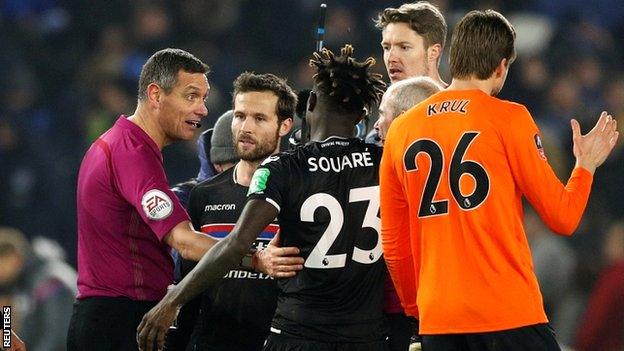
Andre Marriner explains his reasoning to the Palace players after Glenn Murray's winner
VAR can only be used at Premier League stadiums where there is a direct link back to the Premier League studios west of London - where the VAR has access to between 12 and 15 camera angles, including four cameras in each goal.
It will be used in the return leg of Chelsea v Arsenal and implemented in every round of the FA Cup and some further replays, based on broadcaster TV picks and whether the host for each tie is in the Premier League.
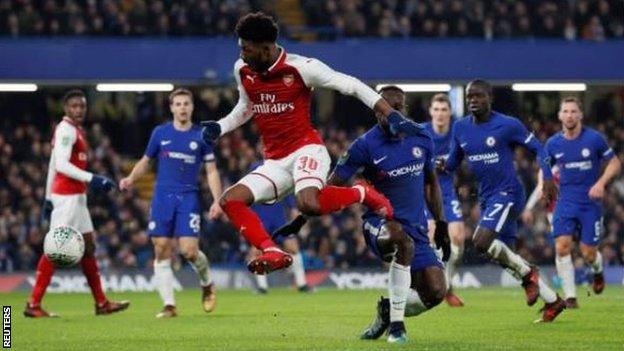
The VAR looked to see whether Victor Moses had fouled Ainsley Maitland-Niles during the Carabao Cup semi-final between Chelsea and Arsenal, but the officials decided to not award a penalty
How often will it be used?
It only took 40 minutes of Serie A's opening game for VAR technology to be used for the first time when it was introduced at the start of this season in Italy.
But since then it has settled down and is now generally used about once in three or four matches, according to former referee David Elleray, the head of refereeing for International Football Association Board.
The technology has also been used in Germany's Bundesliga and in MLS in the United States, and was also available for England's two goalless friendlies with Germany and Brazil last November, which passed without incident.
Has there been opposition to VAR?
Juventus manager Massimiliano Allegri has expressed concern over delays caused by VAR referrals, complaining the game was "turning into baseball".
Fleetwood boss Uwe Rosler is from Germany, whose top flight have used VAR all season. He said: "In general in Germany there is split opinions as it's been tried this season. For me, some situations you can't be 100% on VAR - is the decision right or wrong?
"My opinion is don't complicate the game - it's beautiful as it is. People try to make it different for some reason. I don't like it, it interrupts the flow. Today we were on the wrong side but in general I don't like it."
According to German magazine Kicker, 47% of players wanted to abolish VAR, external in the Bundesliga.
As for those claiming it hands an unfair advantage to teams who benefit from its use, the Football Association says it is a level playing field for both teams, whether the technology is available or not, and point to the fact that a VAR review is not often used.
- Published16 January 2018

- Published9 January 2018
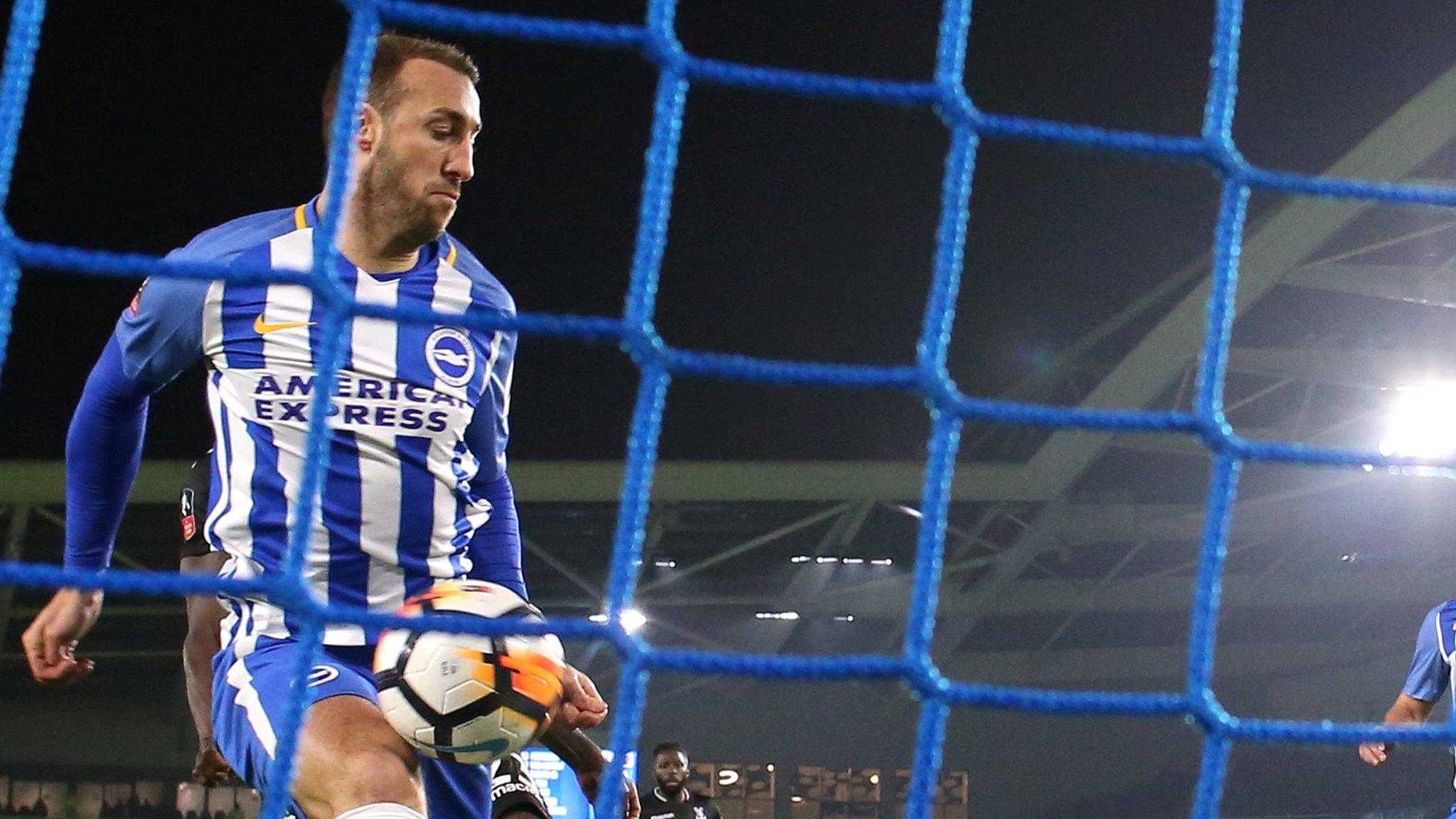
- Published8 January 2018
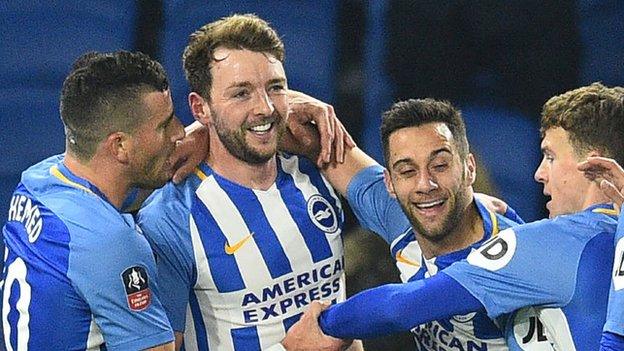
- Attribution
- Published9 January 2018
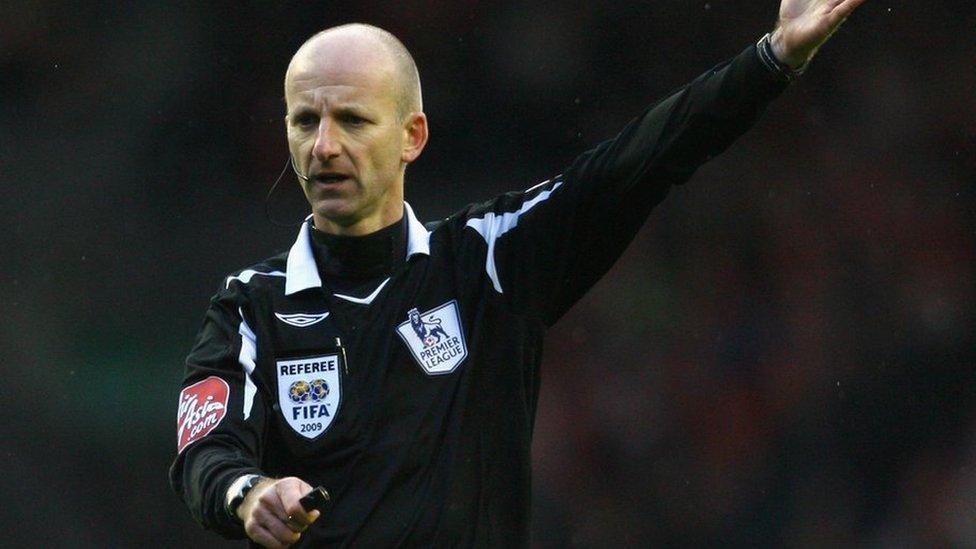
- Published7 January 2018

- Published8 January 2018
